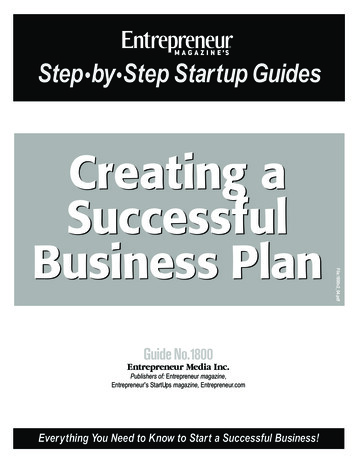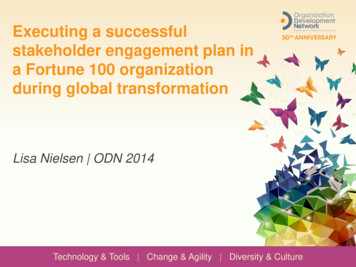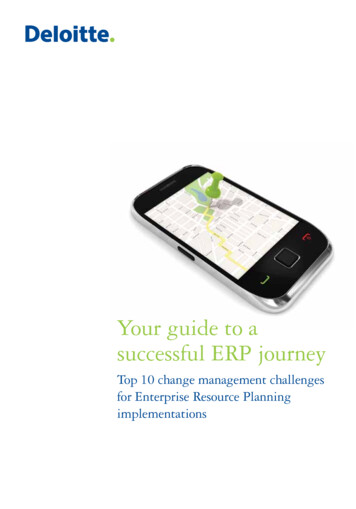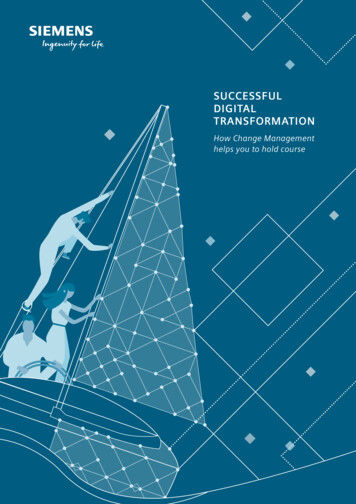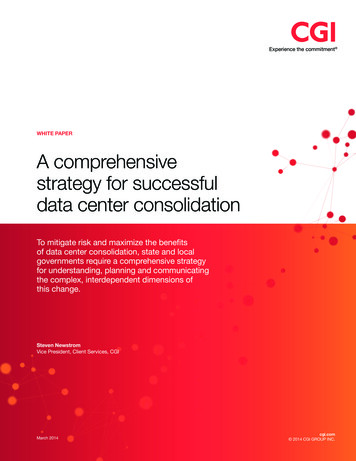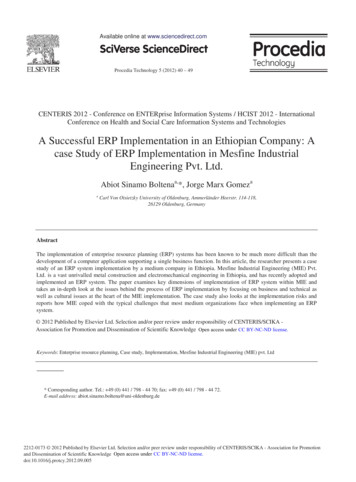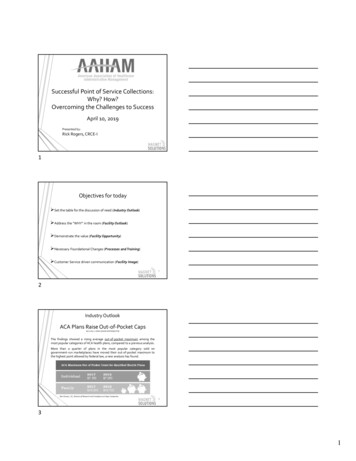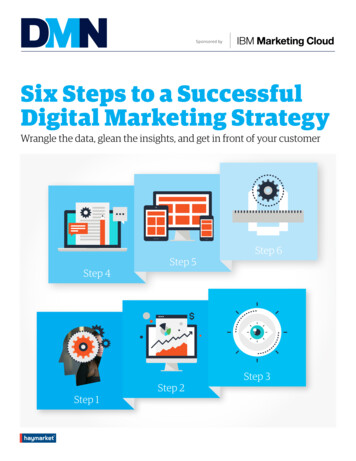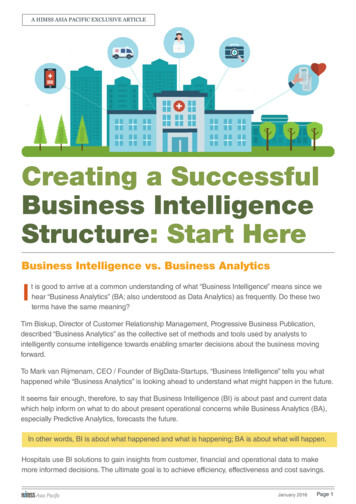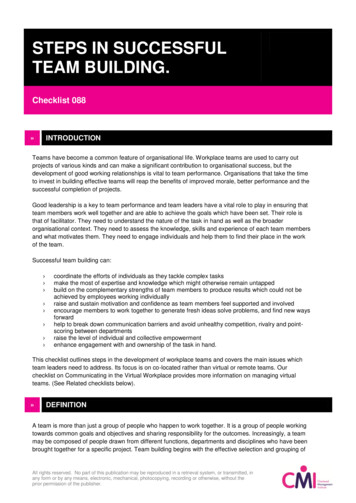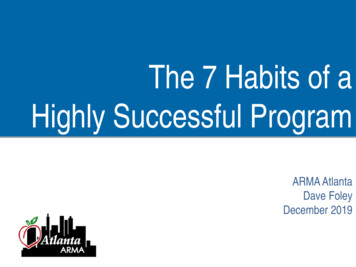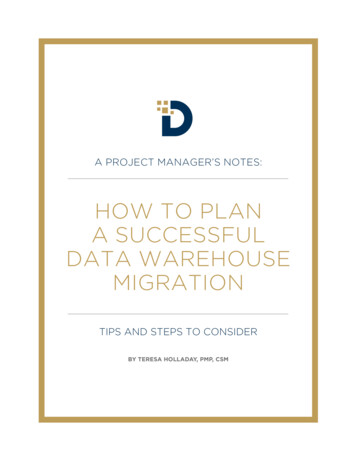
Transcription
A PROJECT MANAGER’S NOTES:HOW TO PLANA SUCCESSFULDATA WAREHOUSEMIGRATIONTIPS AND STEPS TO CONSIDERBY TERESA HOLLADAY, PMP, CSM
Data warehouse migration is one of the hottest trending topics inEnterprise Data Management.In today’s increasingly data-hungry world, the average household is expected to createenough data in the next three years to fill 318 iPhones annually. As a result, businesses havequickly discovered that regardless of time or cost, their analysts simply won’t use data that’sunreliable, irrelevant, difficult to access, or slow to reach their users. Data leads to decisions, andthe generation of increasingly large amounts of data is creating a business demand for datawarehousing and business intelligence.For a data warehouse migration to be successful, the data needs to be trustworthy, deliveredquickly, and be tightly aligned with end-user needs.The purpose of this article is to give project managers and technical architects a fast, easy, andpractical method to plan for a successful project. Although this article covers a data warehousemigration, this method could be applied in other implementations, such as creating a brand newdata warehouse.PART I: WHAT IS A DATA WAREHOUSE MIGRATION?Data warehouse migration is thetransfer of data from old systemsto a new repository. It includes:Moving an existing data warehousefrom one platform to anotherModernizing or upgrading an existingdata warehouse with new and improveddata, structure, hardware, or softwareCreating a new data warehouse from avariety of disparate source systemsVarious factors drive the desire formigration:Business growth, both organic andthrough mergers and acquisitions“The need for speed”The prospect of cost savingsThe potential to use data analytics togrow the businessStandardization across disparatesources or legacy data warehousesRegardless of the type or reason for the migration, the fact remains that these are large, complexefforts. Knowing how to plan is essential.DatasourceConsulting.com
PART II: TIPS TO CONSIDER1TIP 1: GO AGILEOne benefit of Agile is much-improved user interaction, which is a criticalsuccess factor in data migration. Users will see value more quickly andfrequently with the iterative approach than with a traditional waterfall path,and will be able to add input on modifications to increase relevance. Theincreased teamwork, collaboration, and communication in a truly Agileproject can dramatically enhance productivity. You can also opt for a blendedapproach rather than full Agile, depending on which solution makes sense foryour project.We find that even when the corporate culture or nature of the projectsupports a Waterfall approach, there are many advantages to incorporatingAgile values and aspects of an Agile framework.2TIP 2: ENGAGE DATA MIGRATION CONSULTANTS FOR KEYROLES ON THE PROJECT- In-house expertise on new platforms and tools is likely to be limited- For this type of custom effort, the in-house team may not have the strategicplanning, architecture, and build experience- “The old way of doing things” may have already created challenges betweenIT and business users that a new player can help overcome3TIP 3: GO OLD SCHOOL, USE A PROJECT MANAGER(Source: Dave Crolene, “The Agile Data Warehouse”)The level of technical, logical, and political complexity involved in a datawarehouse project goes far beyond other project types. A Project Managerprovides the full-time focus required to manage the intricate release planningprocess and ensures data modeling embraces the complete enterprise – notjust the most prominent subject area. With a Project Manager leading themigration, the project also benefits from risk management and facilitationamong a broad group of participants.DatasourceConsulting.com
4Tip 4: Begin with the End in MindEvery project should start with a principle from Stephen Covey’s book, TheSeven Habits of Highly Effective People, “Begin with the end in mind.”The initiation phase of your project plan is more than a task checklist; it’s howyou start to truly collaborate with both the technical team and the business.The objective is to get a clear picture of the business user’s core needs.Sit down with principal stakeholders to determine their critical successfactors, but don’t stop there. Meet with technical teams, including databaseand system administrators, security, and operations, to find their pain pointswith past implementations. Learn their definition of success.Your highest level success criteria may be defined as a Data Warehouse that is:Accurate – provides trustworthy, reliable data corresponding to thesource system(s)Fast – executes both processing and retrieval times within defined windowsSupportable – captures and easily restarts process failures with exceptionsVerifiable – tests established data quality, including reconciliationUsable – provides reporting ability on today’s data, with additionalcapabilities afforded by historic dataScalable – expands to meet both an increase in volume and new,unexpected dataFlexible – adapts to rapidly changing business needsSecure – appropriately masks data to meet data security requirementsCollaborative – combines in-house and project team personnel andfacilitates knowledge transfer and data warehouse support abilityProvides Operational Success – processes run consistently andsuccessfully across development, test, and production platforms, and canbe executed by in-house usersIn this step, be sure to identify new capabilities the system will deliver,such as data quality, data governance, data masking, new schedulingand BI reporting features, new data sources, and historical capabilitiesthat can facilitate trending.DatasourceConsulting.com
PART III: PLAN TOGETHER USING A DELIVERABLESBASED WORK BREAKDOWN STRUCTURE (WBS)Completing a thoughtful, deliverables-based WBS at the beginning of the project is anotherCritical Success Factor. It helps manage scope and timeline. Stepping through the processhelps team members think through tasks and deliverables and surface potential issues.Because technical teams are usually not familiar with this technique, this is an opportunityfrom the earliest planning stages for the technical architects to work together with theProject Manager to map out a plan.According to the Project Management Institute (PMI), there are several benefits to using a WBS:- Decomposition and better control of the project scope- Improved estimating- Better control of the project execution- More accurate project completion verificationThe WBS informs rather than becomes your schedule. As you plan with your team, it allows youto visually see the work, or scope, you need to complete the projects. With the right discussion, ithelps ensure that you adequately plan for essential activities.How does it work?The Project Manager conducts a short series of planning sessions with the team. Beginningwith known deliverables and scope, work backwards to break down, or “decompose”, thedeliverables. This can be done in a Word document, as shown below, in a project planning tool,or in a highly-visual mind-map tool. The goal is to break down each task into what is needed tocomplete the deliverable.This classic example is from the PMI Practice Standard for Work Breakdown Structures.Project Goal: Build a bicycleScope, expressed in terms of specific deliverable components:Bicycle1. Frame Set (This deliverable isdecomposed for the sake of illustration)a. Frameb. Handlebarc. Forkd. Seat2. Crank Set3. Wheels4. Braking System5. Shifting System6. Integration (bring it all together to createthe bicycle)7. Project ManagementDatasourceConsulting.com
The following mind-map WBS shows the deliverable list visually.As you can see, each deliverable isthen broken down, into its componentparts. For example, the Frame Set isdelineated into Frame, Handlebar, Fork,and Seat.This process continues until eachcomponent is decomposed into small,reasonable work products.Why choose a deliverables-based WBS?Because this is a deliverables-based WBS, it identifies specific components to be delivered. Manytimes, project managers plan based on the activities of a Phase – Analysis, Design, Build, Test,Deploy. But without a deliverables-based WBS, you are only tracking activities, and it would bedifficult to know if the actual work products are proceeding on schedule. You also risk missingareas that should be planned within your scope.Data warehouse migrations are very large projects. In order to deliver on time, it is essential totrack against deliverables. For this reason, we recommend the deliverables-based WBS whenplanning this type of project.Data warehouse migration example: Let’s move from the bicycle example to a datawarehouse migration project.Project Goal: Migrate from a 15-year-old legacy data warehouse to a new data warehouseReason: The legacy ETL software is going out of support so new ETL software has been chosenwith the database platform remaining the same.Scope, expressed in terms of highest level project deliverable components:- Install & configure ETL servers- Data Warehouse- BI Reports- People - Build in-house capabilities for DW/BI to support code and platformDatasourceConsulting.com
Step 1: Identify the highest-level project deliverables.The first level of your WBS contains the highest-level project deliverables. If a deliverable is not onthis list or would not be decomposed via this list, then it’s either not in scope or it should be addedto the list. For example: “Install & Configure BI Report Servers” is not on the list. If this deliverable ispart of your project, or if it’s part of a Statement of Work, it should be part of the WBS.Step 2: Begin to Work Through the Deliverables, Decomposing Each One Down to the Task LevelWe’ll work through each of the four listed above to illustrate the process. These are high level plansthat can be decomposed much further.Install & configure ETL servers1. Determine ETL architecture (single or multiple server installation, high-availability,node, grid)2. Determine hardware specification (size and power)3. Procure hardware4. Set up development servera. Install and configure OS and securityb. Install and configure new database to support ETL softwarec. Install and configure new ETL softwared. Configure backups5. Create Installation Guide specific to this environment6. Set up test server7. Set up production serverData Warehouse1. Determine architecture2. Determine database specification (size and power)3. Define data architecture standards4. Complete data model5. Complete ETL6. Migrate historical data from old data warehouseDatasourceConsulting.com
BI Reports1. Conduct working sessions with users2. Compile an inventory of highest value reports3. Determine best approach for BI Report re-tooling4. Create project plan for BI Report re-tooling5. Complete BI Report conversion to new DW structurePeople - Build in-house capabilities for DW/BI to support code and platform1. Procure software training for in-house Developers2. Establish process to onboard in-house Developers for hands-on coding3. Provide knowledge transfer to in-house Developers4. Provide knowledge transfer to operational support5. Utilize Scrum process6. Conduct WBS planning7. Document operations management and troubleshootingIn a mind-map WBS tool, you can work with your team to easily decompose the deliverables.Step 3: Break each deliverable down to individual tasks able to be estimated. If you are usingScrum, these should be small units that can be completed within a Sprint.DatasourceConsulting.com
Step 4: Enter the Individual WBS Items in your Scrum Board or Other Tasking ToolWhen you get to the lowest level of work products, these become your tasks on a Scrum board.The Scrum board provides many useful capabilities, including measuring work velocity orprogress against a backlog.Every Scrum board tool is different. They are generally hierarchical, reflecting the WBS.The following illustrates a Scrum board for the Data Model deliverable. Each purple feature drillsdown into detailed Product Backlog Items or Tasks.Step 5: Set MilestonesThe next step is to determine which tasks will become Milestones, or, checkpoints along the pathto completion. Using the example given above, a good Milestone could be stated as a CompletePresentation Layer Data Model. This consists of a number of initial tasks, but provides a certainmeasure of completion when finalized.You can see it in Line 27 below.DatasourceConsulting.com
Step 6: Estimate the Lowest Level TasksUntil this point, task effort has not been estimated. We have only broken down higher leveldeliverables into measurable components and provided a milestone to indicate when certaincheckpoints have been reached.Every team will have its own way of estimating. It’s worth learning how to estimate based oneffort, not time, and there are many Scrum resources to help with this. Estimating will happennaturally with collaborative planning to ensure you take all major steps, with tasks broken downinto measurable components.Step 7: Create the ScheduleBy breaking down tasks, determining milestones, and completing estimates, you can create aschedule that realistically reflects the necessary work and completion timeline.PART IV: CONCLUSIONUtilizing a deliverables-based WBS as a project-planning technique provides several benefits:Creates an effective, repeatable process. If you have WBS from previous projects, you canuse it as a starting template for future releases. You will still conduct your collaborativeWBS sessions with the team, but they should go much faster since much has alreadybeen mapped out.Evaluates how to break down the tasks and uncover activities and risks that might otherwisehave been missed, helping you minimize the negative impact to schedule or scope.You can identify realistic milestones and estimate and set milestone dates on the schedule,creating a much better idea of whether your project is on track.1 http://www.infodocket.
practical method to plan for a successful project. Although this article covers a data warehouse migration, this method could be applied in other implementations, such as creating a brand new data warehouse. Data warehouse migration is the transfer of data from old systems to a new repository. It includes: Moving an existing data warehouse
